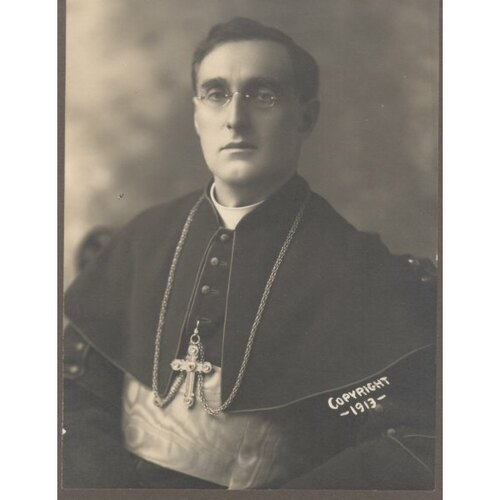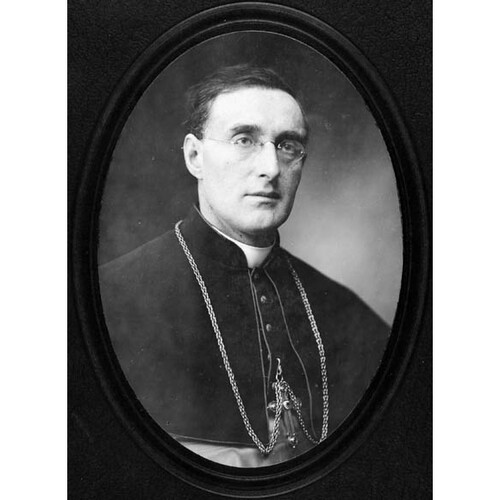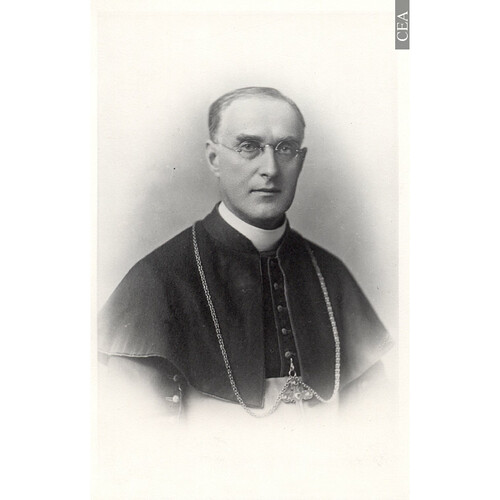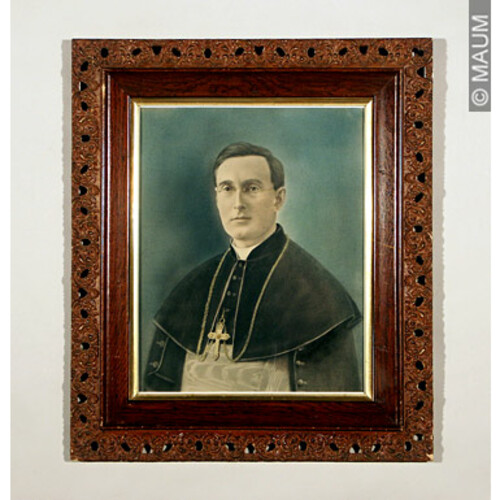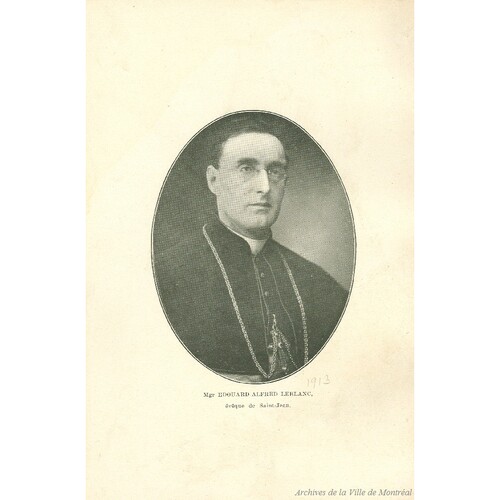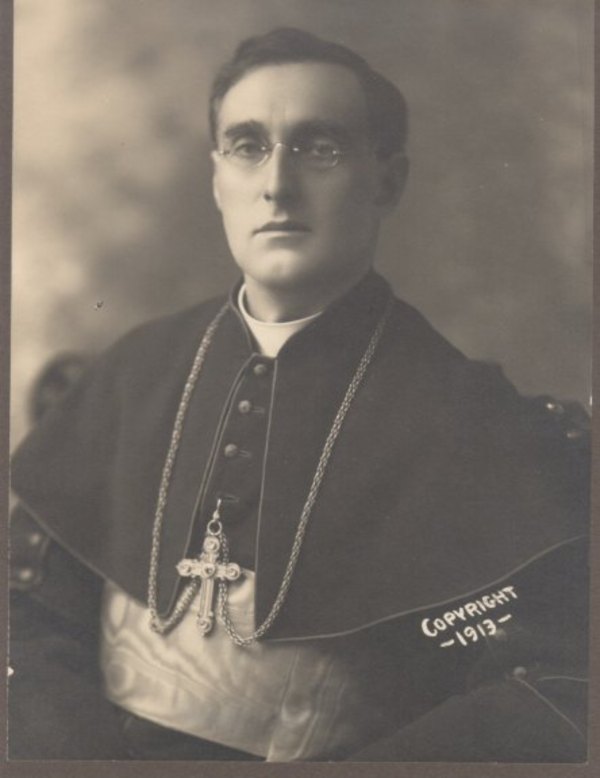
Source: Courtesy of Wikimedia Commons
LE BLANC, ÉDOUARD-ALFRED (named at birth Edward A.; he also signed Édouard), Roman Catholic priest and bishop; b. 15 Oct. 1870 in the parish of St Bernard, in Clare, N.S., son of Luke Le Blanc, a farmer, and Julia Beliveau; d. 17 Feb. 1935 in Saint John, N.B.
Édouard-Alfred Le Blanc was the youngest in a family of five children. His father was a farmer and lumberman of modest means. Nevertheless, Édouard-Alfred completed his education. He attended primary school at Weaver Settlement, a village located about two miles from his home parish. In 1889 he began his classical studies at the College of St Joseph in Memramcook, N.B., under the aegis of the Holy Cross Fathers. He stayed there for two years and then entered the Collège Sainte-Anne at Church Point, N.S. [see Gustave Blanche*], which was administered by the Eudists. He was among the first cohort of students to enrol in that institution, which opened its doors in the fall of 1891. While there, he won many prizes for excellence, especially in religious education. His enthusiasm attracted the attention of the authorities, who encouraged deserving students to enter the priesthood. Le Blanc completed his program in 1895 and continued his studies at the new Eudist seminary in Halifax: Holy Heart Seminary. After three years at that institution, he was ordained priest in St Mary’s Cathedral, during a ceremony presided over by Archbishop Cornelius O’Brien*.
For the next 14 years Le Blanc would remain in the archdiocese of Halifax. Beginning as vicar in the parish of Stella Maris in Meteghan (1898–1901), he went on to serve as curé in the parishes of St Jérôme in West Caledonia (1901–6); St Vincent de Paul in Salmon River (1906–7); and St Bernard, his home parish (1907–12). At the latter he distinguished himself through his support for the temperance movement and his involvement in the construction of a new granite church in the Gothic style (1910–42). He was also known for his love of such outdoor activities as hunting and fishing.
Le Blanc became bishop of the diocese of Saint John, N.B., in 1912. Acadian nationalists had been calling for the appointment of an Acadian to the upper levels of the administration of the Roman Catholic Church in the Maritimes for at least two decades [see Sir Pierre-Amand Landry*]. Prudence seems to have motivated the authorities in their choice. In fact, since Le Blanc had not previously participated in the Acadian nationalist movement, his election would likely reassure the Irish clergy, who were a dominant group in the ecclesiastical hierarchy of the Maritimes [see Stanislas-Joseph Doucet*].
From the first year of his episcopate, however, Le Blanc had to confront the demands of Acadian nationalists. As early as 1908 he received a letter from railway employee Henri-P. Le Blanc on behalf of a group of Acadian militants in Moncton. He expressed their desire to separate the French Catholic community from the parish of St Bernard, which was under the authority of the bishop of Saint John, and to create another, one that would be entirely French speaking and served by an Acadian priest. The Anglo-Irish ecclesiastical hierarchy of New Brunswick and the archbishop of Halifax, Edward Joseph McCarthy, challenged the plan. Le Blanc convened a public meeting of St Bernard’s French-speaking parishioners, which took place without the presence of their curé, Edward Savage, who was also opposed to the idea. The meeting was held in the church on 29 Sept. 1913. The vote that followed indicated almost unanimous backing for the creation of a new parish. On 22 Jan. 1914 Le Blanc lent his support to the popular will, described the procedure required to divide the property between the two groups of parishioners, and confirmed the foundation of the parish of L’Assomption. The Acadian nationalists – including the leaders of the La Tour branch of the Société l’Assomption [see Rémi Benoît*] – regarded Le Blanc’s actions as significant since they established a precedent within the Catholic Church in the Maritimes: the recognition of language as a criterion in the development of ecclesiastical organization. During the remainder of his episcopate, Le Blanc would have very little interaction with Bishop McCarthy regarding the representation of francophones within the Catholic hierarchy of the Maritimes.
The nationalist demands were next directed at the diocese of Chatham in northeastern New Brunswick. In 1917 the physician Albert-Marie Sormany* and the French-speaking curés of the Chatham diocese organized a petition asking the Vatican authorities to put an Acadian bishop in charge of the diocese, where, according to the most recent census, Acadians made up about 80 per cent of the population. They also hired an agent to present their request. In 1920 the death of the bishop of Chatham, Thomas Francis Barry, provided Le Blanc with the opportunity to support the petitioners while still respecting institutional protocol. In February he wrote a letter to Cardinal Gaetano de Lai in which he maintained that the ecclesiastical authorities in the Maritimes “never support the appointment of a French bishop without being forced to do so by the Holy See.” The following month he sent another letter to the apostolic delegate to Canada and Newfoundland, Mgr Pietro di Maria. Presenting himself as the “defender of the Acadians, [who are] too often ignored and humiliated,” he strongly recommended the appointment of Patrice-Alexandre Chiasson. Next, he undertook a journey to Rome to explain in person the validity of the Acadians’ request. The Vatican authorities quickly made their decision known: that year Chiasson became bishop of the diocese of Chatham.
From that time on, Le Blanc benefitted from having an Acadian compatriot within the ecclesiastical hierarchy of the Maritimes. Together, the two bishops formulated a strategy to bring to fruition an undertaking that had been very dear to the Acadian nationalists since the 1880s: the creation of an archdiocese in Moncton headed by an Acadian. The plan was presented as an excellent way to fend off linguistic and religious assimilation. In 1933 their proposal was submitted to the authorities in Rome through the apostolic delegate to Canada and Newfoundland, Mgr Andrea Cassulo.
As a result of conditions caused by thrombosis, Édouard-Alfred Le Blanc, the first Acadian bishop, died in Saint John on 17 Feb. 1935 without learning the outcome of this request: the following year it would lead to the creation of the archdiocese of Moncton, headed until 1941 by Archbishop Louis-Joseph-Arthur Melanson. As bishop, Le Blanc’s involvement in the struggles for the recognition of the Acadian community’s rights had been expressed through the positions he took and through concrete actions. His dedication to the realization of Acadian ambitions within the Catholic Church in the Maritimes is undisputed. In 1912 the Université Laval at Quebec awarded him an honorary doctorate in theology.
Arch. du Centre Acadien (Church Point, N.S.), MG 1; MG 26. Arch. of the Archdiocese of Halifax-Yarmouth (Halifax), J. M. McCarthy papers, vol.1, no.9 (Mgr McCarthy, archbishop of Halifax, to Mgr Peregrine Stagni, apostolic delegate of Canada, 17 May 1912); vol.3, no.301 (letter from Mgr Édouard Le Blanc and Mgr Patrice Chiasson to Thomas O’Donnell, archbishop of Halifax, 20 March 1933). Arch. of the Diocese of Saint John, N.B., Le Blanc papers. NSA, “Nova Scotia hist. vital statistics,” Digby County, 1871: www.novascotiagenealogy.com (consulted 16 April 2015). PANB, MC290 (Diocèse catholique romain de Bathurst/Roman Catholic Diocese of Bathurst fonds), F7668, 30 mars 1933; RS141C5, F18995, 17 Feb. 1935. Univ. de Moncton, Centre d’Études Acadiennes Anselme-Chiasson (N.-B.), 1.58-13; 24.20.3; 25.1-3, 25.5-2A; F2115, 2 juill. 1907. L’Action catholique (Québec), 18 févr. 1935. L’Évangéline (Weymouth, N.S.), 30 juin 1892, 29 juin 1893, 20 juin 1901, 21 févr. 1935, 3 sept. 1936. N. J. Boucher, “Acadian nationalism and the episcopacy of Msgr. Édouard-Alfred LeBlanc, bishop of Saint John, New Brunswick (1912–1935): a Maritime chapter of Canadian ethno-religious history” (phd thesis, Dalhousie Univ., Halifax, 1992). P. P. Gaudet, “Arbre généalogique de Mgr Edouard LeBlanc, évêque de Saint-Jean, N.-B. [Premier évêque acadien],” BRH, 18 (1912): 357–63. LeBlanc, DBECC. Holy Heart Seminary: an album commemorating the fiftieth anniversary of Holy Heart Seminary (Halifax, 1946). [Élie LeBlanc], Église Saint Bernard: commencée en 1910, complétée en 1942 ([Yarmouth, N.S., 1942?]). P. E. LeBlanc, “The Vatican and the Roman Catholic Church in Atlantic Canada: policies regarding ethnicity and language, 1878–1922,” in Papal diplomacy in the modern age, ed. P. C. Kent and J. F. Pollard (Westport, Conn., and London, 1994), 65–74. Edward Savage, Thirty years in Moncton ([Moncton?, 1934?]). M. S. Spigelman, “Race et religion: les Acadiens et la hiérarchie catholique irlandaise du Nouveau-Brunswick,” RHAF, 29 (1975–76): 69–85. Léon Thériault, “The Acadianization of the Catholic Church in Acadia (1763–1953),” in The Acadians of the Maritimes: thematic studies, ed. Jean Daigle (Moncton, 1982), 271–339.
Cite This Article
Phyllis E. LeBlanc, “LE BLANC, ÉDOUARD-ALFRED (Edward A., Édouard),” in Dictionary of Canadian Biography, vol. 16, University of Toronto/Université Laval, 2003–, accessed January 2, 2026, https://www.biographi.ca/en/bio/le_blanc_edouard_alfred_16E.html.
The citation above shows the format for footnotes and endnotes according to the Chicago manual of style (16th edition). Information to be used in other citation formats:
| Permalink: | https://www.biographi.ca/en/bio/le_blanc_edouard_alfred_16E.html |
| Author of Article: | Phyllis E. LeBlanc |
| Title of Article: | LE BLANC, ÉDOUARD-ALFRED (Edward A., Édouard) |
| Publication Name: | Dictionary of Canadian Biography, vol. 16 |
| Publisher: | University of Toronto/Université Laval |
| Year of publication: | 2021 |
| Year of revision: | 2021 |
| Access Date: | January 2, 2026 |


